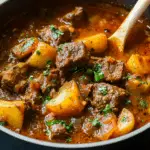Origins and Cultural Significance
The Basque cheesecake, or “tarta de queso,” hails from the town of San Sebastián in Spain’s Basque Country. It was originally created in the 1990s at La Viña, a famous local bar that sought to craft a cheesecake that differed from classic versions by embracing a burnt exterior and rich, creamy interior. This dessert quickly gained popularity for its bold flavors and approachable preparation, reflecting the Basque culture’s appreciation for simple, high-quality ingredients prepared with care and creativity. Today, it is enjoyed globally and frequently appears on menus in both casual and fine dining establishments, symbolizing a modern twist on a timeless favorite.
Unique Characteristics of the Burnt Basque Cheesecake
What makes this cheesecake truly unique is its baking method and resulting texture. Unlike traditional cheesecakes that are baked at low temperatures in water baths to achieve a smooth and pale surface, this Basque version is baked at a high temperature without a water bath. The high heat encourages the Maillard reaction and caramelization on the surface, resulting in the signature burnt top that provides a slightly bitter, smoky contrast to the sweet and creamy interior. This burnt crust adds complexity and depth to the flavor, enhancing the overall eating experience.
The interior, meanwhile, remains soft and custard-like, a result of the rich cream cheese and whipping cream combined with eggs and flour. The cake’s softness means it wobbles slightly when removed from the oven, and it continues to set as it cools and chills in the refrigerator. This custard texture is often compared to a delicate flan or crème brûlée but with the richness of cheesecake.
Simplicity and Elegance in Preparation
One of the reasons this cheesecake has become a beloved recipe worldwide is its simplicity. The absence of a crust eliminates a common baking step, making the process less intimidating. The ingredient list is straightforward, with cream cheese, sugar, eggs, cream, and a touch of flour providing all the richness and structure needed. The use of lemon juice and vanilla extract adds subtle brightness and aroma, balancing the sweetness and richness of the cake.
The batter’s silky smoothness is essential for the final texture, which is why passing it through a sieve before baking ensures no lumps interfere with the custard’s delicate nature. The lined springform pan with parchment paper, extending beyond the edges, allows the batter to rise freely and develop its rustic shape as it bakes, further contributing to its signature look.
Flavor Profile and Texture Experience
The interplay between the deeply caramelized, almost burnt exterior and the luscious creamy center creates a delightful flavor contrast that is both comforting and sophisticated. The burnt top has a bittersweet, smoky taste that prevents the dessert from being overly sweet, while the interior is rich, velvety, and mildly tangy thanks to the cream cheese and lemon juice. This combination of flavors keeps the palate engaged and makes each bite complex yet harmonious.
The texture also plays a vital role in the appeal. The outer crust provides a slightly firmer bite, while the interior is creamy and custardy, with a melt-in-your-mouth sensation. This contrast in texture, combined with the balance of flavors, is what elevates this cheesecake from an ordinary dessert to an extraordinary indulgence.
Serving Suggestions and Pairings
Creamy Burnt Basque Cheesecake is versatile in how it can be served. It is often enjoyed on its own, letting the rich flavors shine without distraction. However, it can also be paired with fresh berries, a drizzle of fruit compote, or a light dusting of powdered sugar for added sweetness and color contrast. Some enjoy it alongside a dollop of whipped cream or a scoop of vanilla ice cream to complement its creamy texture.
Beverage pairings include coffee, espresso, or dessert wines like a late harvest Riesling or Pedro Ximénez sherry, which complement the cheesecake’s richness and caramel notes beautifully. Its rustic and elegant nature makes it suitable for both casual family gatherings and formal dinner parties.
Nutritional Aspects
This cheesecake is rich and indulgent, primarily due to its high cream cheese and whipping cream content, which contributes to a significant fat and protein profile. While the sugar content is relatively high, it is balanced by the tartness from the lemon juice and the bitterness from the burnt top, which helps temper the sweetness. It is best enjoyed in moderation as a decadent treat, especially for those mindful of their sugar and fat intake.
Tips for Success
Achieving the perfect Basque cheesecake involves a few key techniques. Using room temperature ingredients ensures the batter mixes smoothly without lumps. Avoiding overmixing once the eggs are added helps maintain a tender texture. Baking at the right high temperature is crucial to developing the signature burnt top while keeping the center soft. It’s important to allow the cheesecake to cool completely in the pan before refrigerating so it sets properly without cracking. Removing the parchment carefully prevents damage to the delicate edges.
Why It’s Perfect for Home Bakers
The Burnt Basque Cheesecake is an excellent option for home bakers seeking an impressive dessert without complicated steps or equipment. Its forgiving nature means slight imperfections do not detract from its appeal, and the rustic look is part of its charm. It also requires fewer ingredients than many classic cheesecakes, making it budget-friendly and accessible. Whether you’re baking for a special occasion or simply want a luxurious treat, this cheesecake delivers a restaurant-quality experience with minimal fuss.
Conclusion
Creamy Burnt Basque Cheesecake offers a delicious and visually stunning dessert that defies traditional cheesecake norms through its unique burnt exterior and luxuriously creamy interior. Its origins in Spain’s Basque region have given it a rich cultural heritage, while its simplicity and bold flavors have made it a modern favorite worldwide. This cheesecake balances sweetness, creaminess, and a slight bitterness with a custard-like texture that melts in your mouth. Ideal for both novice and experienced bakers, it transforms simple ingredients into an indulgent masterpiece that fits any occasion. Whether served plain or with accompaniments, it promises a memorable dessert experience that will impress family, friends, and guests alike.






